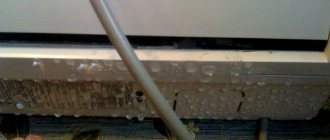Failure to comply with operating conditions
A common cause of malfunctions is non-compliance with operating rules. Steam irons have a temperature regulator with special marks that will help you determine when you can use the steam boost. If the surface of the sole is heated to the optimal temperature, water will flow through the holes.
How to adjust the steam supply
Before turning on the steam release function, you need to set the temperature appropriate for the type of fabric, place the iron in a vertical position, and wait until the special indicator goes off, signaling that it is ready for use. Many people do not comply with these requirements, as a result of which the iron quickly fails.
Important! During ironing, the lid of the water tank must be tightly closed, this is indicated by a click when closing. This will prevent liquid from getting onto the fabric.
Scale
The device is operated according to all the rules, but water flows from the sole. This option is possible and it is scale. Deposits are not difficult to remove with a special solution or rod, if available.
Rusty water usually oozes from the soleplate of the iron and the ironed item in this case becomes irrevocably damaged.
It’s easy to descale your iron yourself. To do this, you will need to dissolve citric acid in water and pour it into the device’s reservoir. The device must be heated to maximum temperature. Then, after the indicator turns off, you need to shake the solution and feed it into the steam chamber. Repeat the procedure until the tank is completely cleaned.
With iron models equipped with a scale removal rod, everything is much simpler. An effective solution is a solution containing acetic and citric acids. The rod must be kept in the prepared mixture for at least 2 hours.
Water instead of steam during the ironing process indicates a malfunction of the device. Contacting a service center is the best option to solve the problem.
AllaAuthor of the article
Did you like the article?
Share with your friends:
Low temperature
The operation of the device is based on the supply of water through a valve from the reservoir to the inside of the sole. There is a regulator on the body, with its help you can change the size of the holes so that the liquid flows in the required portions. Under the influence of high temperatures, water is converted into steam, which comes out through special holes on the sole.
In order for the vaporization process to be successful, it is necessary to reach the boiling point of water. The inner sole of the iron should reach this temperature.
If this value is not reached, the water will not turn into steam, but will flow out through the holes in the sole.
Common causes of water leaking from an iron
Water may leak from the iron if the valve of the device is broken or the device is used incorrectly.
Broken valve
Water from the water tank is supplied to the inner surface of the sole. A steam regulator is built into the housing. They can be used to regulate the intensity of the steam jet. When the device heats up, the water turns into steam and steams unironed folds in the laundry.
If there is still water in the tank and the iron has cooled down, then it may leak when the valve is closed. The cause of the leak is a broken valve.
The malfunction should be checked as follows: turn off the steam supply and, without turning on the iron, shake it, placing it in a horizontal state. If water flows out, it means the valve does not regulate the flow of steam into the soleplate of the iron. Often the malfunction lies in wear and loss of elasticity of the rubber valve gasket.
Incorrect operation
After turning on the device, if the iron has not heated up to the optimal temperature, then steam has not yet formed and water begins to leak through the holes, which the valve has “distilled” into the steam chamber.
How to avoid water leaking out of the iron during operation?
To avoid liquid leaking out of the holes on the soleplate, you should wait until the iron warms up each time.
This is done correctly like this: turn on the steam mode, set the desired temperature, turn the iron vertically, wait until the heating indicator turns off and begin ironing things.
The water filling hole must be closed after filling the tank. This way, drops will not get on the fabric and will not leave wet spots.
What to do when water flows from the iron
The iron needs to be descaled from time to time. This procedure is easy to carry out at home.
Method 1
- Dissolve citric acid powder in water;
- Pour the solution into the reservoir;
- Set the iron to maximum temperature;
- We wait until the indicator goes out;
- Lightly shake the device and add water to the steam chamber;
- Repeat until completely clean.
What will happen? Water touches the hot heating element. In this case, the hot and cold surfaces come into contact, adding exposure to an acidic environment. The scale lags behind the walls and comes out through the holes in the sole of the iron. In the same way, you can wash away any debris that has gotten into the sole of the device.
Rust
Exposure to water may cause rust to appear on the metal on the inside sole of the device. Its appearance is caused by the flow of water.
Rust on the soleplate of the iron stains clothes
It is enough to eliminate this problem, then there will be no rust. You can get rid of rust using a chemical pencil.
Water leaks from the iron: possible causes and ways to eliminate them
Modern irons, to the delight of housewives, are equipped with a steaming function. It helps to quickly and efficiently iron even heavily wrinkled items, which means it significantly saves time and, at the same time, nerves. There is indeed one small fly in the ointment in this barrel of honey. Sometimes water starts flowing out of special holes on the soleplate of the iron instead of steam. And this slows down ironing. In addition, if there is scale inside the water tank, rust may leak out onto your clothes along with the water, which can irreparably ruin things. In order to understand why an iron leaks, you should understand by what principle steam turns into water in this device, and what components are responsible for this.
How it works?
The operating principle of the steam supply mechanism in such a device is very simple. Water is initially poured into a special tank. By the way, for irons and steamers it is best to use a special distilled liquid. Only in this case will you be able to use the device for a long time without fear of scale appearing on it. From this reservoir water is supplied to the soleplate of the iron. The sole is the lower part or simply the bottom. The liquid is supplied via a control valve. It, in turn, regulates the power of water flow depending on the heating temperature of the device. Water that gets into the soleplate of the iron is exposed to high temperatures. It is at this moment that the process of its transformation into steam occurs.
Reason #1: improper operation
If water flows from the iron instead of steam, the appliance may not be used correctly. There is a special mark on the power regulator of most devices of this type. It shows at what temperature you can start using the steam function. This means that in this mode, the temperature of the device will allow the water to transform into steam. If you activate the steaming mode at a time when the switch is not set correctly, water will flow out of the special holes on the bottom of the device. Be sure to pay attention to this before steaming your clothes.
Reason No. 2: valve failure
If you operate the device exactly according to the instructions, but the iron still leaks, then the problem may be hidden in a valve malfunction. What to do in this case? First, you need to figure out whether the valve through which water flows from the reservoir into the sole is really faulty. You can check this in a simple way. Close the valve. To do this, set the switch to any mode except steam supply. After this, pour water into the tank and place the device in a horizontal position. Take the iron in your hand and swing it from side to side. If water begins to emerge from the steam supply holes, the valve is not completely closed. Therefore, the cause of such an unpleasant phenomenon during ironing is the breakdown of one of the components of the iron.
What to do
During ironing, too much steam may be generated, the excess of which condenses on the outer surface of the soleplate. After the sole comes into contact with the fabric, wet marks may remain. This is also a manifestation of liquid leakage during ironing.
Sometimes the liquid takes on a rusty tint, which can ruin the fabric. As a result of prolonged use, scale may appear.
When filling the container, it is important to ensure that the liquid is clean, otherwise components such as chemicals and starch will get into it. These components can become inhibitors in the vaporization reaction, they will slow down this process, resulting in water leaks through the holes in the sole.
To eliminate all unnecessary substances, it is important to flush the tank so that these substances do not mix with the water.
Important! To prevent foreign substances from entering the tank, only distilled water should be poured into it.
Common causes of water leaking from an iron
It happens that water may start to flow due to problems with the iron valve during regular improper use of the equipment.
Broken valve
Water is supplied from a special tank. The moisture then hits the inside of the hot surface. The case already has a factory-installed steam regulator. It is he who regulates the supply of steam. During the heating process, water turns into steam and the laundry is steamed.
When there is water left in the tank and the iron has already begun to cool down, water may begin to flow. The reason is that the valve itself is broken.
How to check the fault? First you need to turn off the steam mode and shake the iron thoroughly without connecting it to the mains. If water starts to flow while lying down, the valve stops regulating the correct activation of the steam mode and the supply of steam itself. Very often the cause of the malfunction is wear of the gasket in the valve.
EasySpeed Steam Iron
The information on this page applies to models: GC1742/40, GC4537/70, GC7933/30, GC7920/20, GC4563/30, GC4544/80, GC8942/20, GC9324/20, GC4556/20, GC2676/20, GC26 78/ 30, GC2670/20, GC2142/40, GC8712/20, GC2145/20, GC2671/50, GC3675/30, GC2148/30, GC1433/30, GC6709/26, GC4938/20, GC6709/21 GC4932/20 GC9682/80, GC9660/30, GC6709/20, GC5036/20, GC4934/30, GC2994/20, GC2998/80, GC1426/70, GC1425/40, GC7051/30, GC2996/20, GC7 805/20, GC7833/ 80, GC7808/40, GC7057/20, GC4517/20, GC4526/20, GC4525/30, GC4887/00, GC1424/30, GC3582/20, GC3584/30, GC4516/40, GC4527/00 GC4885/00 GC1436/20, GC1029/40, GC4595/40, GC4929/80, GC2980/70, GC2982/30, GC4924/20, GC9642/60, GC6631/30, GC7635/30, GC7035/20, GC4 914/27, GC8651/ 10, GC3802/20, GC4522/00, GC4521/20, GC4520/30, GC4512/20, GC4511/40, GC4510/30, GC3821/70, GC3820/20, GC3803/30, GC3811/70 GC9247/30 GC8650/80, GC2045/26, GC1022/40, GC2048/80, GC2048/30, GC2046/20, GC2045/40, GC2042/40, GC2040/70, GC1028/20, GC1026/30, GC4 914/20, GC4919/ 80, GC3720/32, GC3760/32, GC3740/32, GC2965/35, GC4860/25, GC4845/15, GC2905/50, GC9246/02, GC9231/02, GC2960/50, GC2930/30 GC2920/70 GC2910/20, GC2907/20, GC2906/70, GC5050/02, GC5060/02, GC8620/02, GC8640/02, GC4810/02, GC4851/02, GC4850/02, GC4890/02, GC4 870/02, GC4860/ 02, GC3551/02, GC7530/02, GC9230/02, GC2710/02, GC2720/02, GC2965/02, GC9245/02, GC3720/02, GC3760/02, GC2906/02, GC2960/02 GC2930/02 GC2920/02, GC2910/02, GC2907/02, GC6520/02, GC8330/02, GC6530/02, GC3560/02, GC3540/02, GC2806/02, GC2807/02, GC1905/01, GC1 960/02, GC4490/ 02, GC4720/02, GC4740/02, GC2810/02, GC2820/02, GC2830/02, GC3660/02, GC3620/02, GC3640/02, GC8420/02, GC7320/02, GC6420/03 GC6440/02 GC6430/02, GC3388/22, GC3390/02, GC3310/02, GC4610/02, GC4640/02, GC4630/02, GC4625/02, GC4620/02, GC3106/02, GC3388/02, GC1 705/01, HI518/ 02, GC8260/02, GC8220/02, GC651/02, GC4440/02, GC4430/02, GC4340/02, GC4330/02, GC4325/02, GC4320/02, GC3340/02, GC3330/02 GC3321/02 GC3320/02, GC3240/02, GC3230/02, GC3221/02, GC3220/02, GC2528/02, GC2520/02, GC2510/02, GC1820/02, GC1815/02, GC7230/02, GC6 320/03, GC4410/ 02, GC4425/02, GC4420/02, GC6310/03, GC1701/01, GC650/02, GC2650/03, GC2640/03, GC2560/02, GC2530/02, GC1830/02, GC1720/02 GC1710/02 GC1703/01, GC1110/02, GC6360/02, GC4310/02, GC3740/02, GC3109/02, GC1010/01. Click here to show more product numbers Click here to show fewer product numbers











